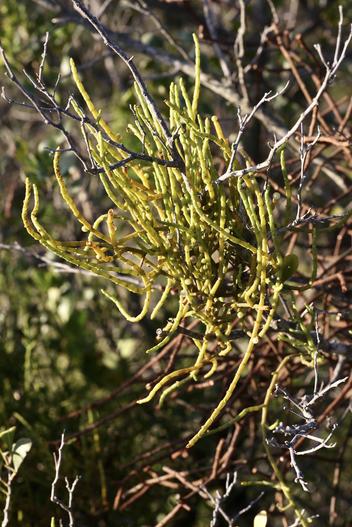Australian Mistletoe
(Viscum triflorum)
Australian Mistletoe (Viscum triflorum)
/
/

Dr. Alexey Yakovlev
CC BY-SA 2.0
Image By:
Dr. Alexey Yakovlev
Recorded By:
Copyright:
CC BY-SA 2.0
Copyright Notice:
Photo by: Dr. Alexey Yakovlev | License Type: CC BY-SA 2.0 | License URL: https://creativecommons.org/licenses/by-sa/2.0/ | Uploader: Dr. Alexey Yakovlev | Publisher: Flickr

Estimated Native Range
Summary
Viscum triflorum, commonly known as Australian Mistletoe, Three-flowered Mistletoe, or Spreading Mistletoe, is a hemiparasitic evergreen shrub native to a variety of habitats in Australia, including rainforests, woodlands, and open forests. It is particularly common in eucalypt woodlands and acacia scrub. This mistletoe typically grows attached to the branches of host trees, reaching sizes that vary depending on the size of the host. Its stems are slender and spreading, and it has leathery, green leaves that are often mistaken for those of its host plant.
Australian Mistletoe is notable for its yellow or green flowers, which are showy and bloom in the summer. The flowers are followed by sticky, white berries that are attractive to birds, which play a crucial role in seed dispersal. In cultivation, it is not commonly grown due to its parasitic nature, but it can be used for research or conservation purposes. It requires a host plant to grow and does best in conditions that mimic its natural habitat, which includes full sun or part shade, and it is not particular about soil type as it derives most of its nutrients from its host. There are no popular garden cultivars due to its parasitic lifestyle. Potential problems include the ethical considerations of deliberately introducing a parasitic plant into a garden setting, as it may spread to unintended host plants.CC BY-SA 4.0
Australian Mistletoe is notable for its yellow or green flowers, which are showy and bloom in the summer. The flowers are followed by sticky, white berries that are attractive to birds, which play a crucial role in seed dispersal. In cultivation, it is not commonly grown due to its parasitic nature, but it can be used for research or conservation purposes. It requires a host plant to grow and does best in conditions that mimic its natural habitat, which includes full sun or part shade, and it is not particular about soil type as it derives most of its nutrients from its host. There are no popular garden cultivars due to its parasitic lifestyle. Potential problems include the ethical considerations of deliberately introducing a parasitic plant into a garden setting, as it may spread to unintended host plants.CC BY-SA 4.0
Plant Description
- Plant Type: Shrub
- Height: 1-2 feet
- Width: 1-2 feet
- Growth Rate: Moderate
- Flower Color: Yellow, Green
- Flowering Season: Summer
- Leaf Retention: Evergreen
Growth Requirements
- Sun: Full Sun, Part Shade
- Water: Medium, High
- Drainage: Medium
Common Uses
Bird Garden, Low Maintenance, Showy Flowers
Natural Habitat
Native to a variety of habitats in Australia, including rainforests, woodlands, eucalypt woodlands, and acacia scrub
Other Names
Common Names: Three-flowered Mistletoe, Spreading Mistletoe
Scientific Names: , Viscum triflorum,
GBIF Accepted Name: